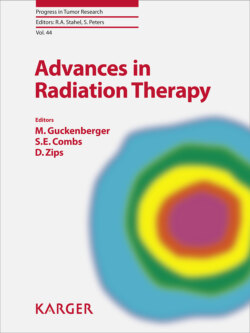Читать книгу Advances in Radiation Therapy - Группа авторов - Страница 33
На сайте Литреса книга снята с продажи.
PET Imaging
ОглавлениеPET imaging relies on the emission of a positron. Within a few millimeters of maximal emission, this (positive) positron undergoes annihilation with a (negative) electron, converting the masses into one pair of so-called annihilation photons. These 511-keV photons are emitted in about 180° opposing directions (“back-to-back”). The photons are almost simultaneously (within 6–12 ns) detected by the PET, which allows assignment of the photons to annihilation on a certain “line of response.” PET typically has an image resolution of about 5 mm, which is much larger than the scale of the biological processes being visualized.
Fig. 2. The influence of hypoxia and accelerated proliferation on the effect of radiotherapy.
Within human tissue, the half-value layer of 511-keV photons is about 7 cm. Therefore, PET images need to be corrected for attenuation. Commonly, a low-dose CT is made consecutively and used for attenuation correction. This CT is also the anatomical reference image for the PET images, to aid interpretation. Depending on the investigated tissue, it is important to understand that CT usually leads to a “snapshot” image, while PET acquisition takes at least minutes and, without a gating image, is influenced by breathing motion and heart-beating, etc. This can lead to a local mismatch between PET and CT.
PET imaging can be performed with different radionuclides, as long as positrons are being emitted. The radionuclide can be attached to a “tracer,” which is used as a vehicle and key, to lead the radionuclide to and into the tissue to be visualized. After intravenous administration, uptake and accumulation of the tracer in the target tissue takes some time. For 18F-FDG PET this is about 1 h. For hypoxia imaging this can rise up to 4 h. If not enough time is allowed every tracer is reduced to a marker of blood perfusion. Therefore, the half-life of the radionuclide should be long enough for sufficient signal at the moment of imaging. To limit the radiation dose due to the administration, the half-life should not be unnecessary long. The most used radionuclide is 18F, which has a half-life of 110 min. 18F needs to be produced in a cyclotron, but due to this half-life it can be transported after production and be used at a different location. It does not need to be produced and used on site.
The resulting PET images are quantitative, which means that voxel values correspond to the actual activity in the patient (Bq/mL). Assessment of the uptake is usually done by calculation of the “standard uptake value” (SUV) or a derivative. The SUV is the uptake in the tissue, corrected for injected activity and patient weight. In other words, if the activity was completely homogeneously distributed over the entire body, the SUV would be 1 in the whole body. If it all accumulated in half the body, the SUV would be 2 in that part and 0 in the remainder. Frequently used derivatives are SUVmax (maximum SUV in the region of interest; ROI), SUVmean (average SUV in the ROI), SUVpeak (the average SUV of a 2D or 3D ROI with a 1.2-cm diameter over the tumor area with the highest uptake [15]), MTV (metabolic tumor volume, tumor volume measured with a fixed or relative threshold, e.g., 50% of the max [15]), and TLG (total lesion glycolysis = MTV × SUVmean).
In the case of very local uptake (<2× full width of half the maximum of the system), the partial volume effect should be considered. Spillover in neighboring voxels reduces the visualized activity, and therefore reduces the SUV.
Since there are so many options in preparation, image acquisition, and image interpretation, standardization is required to enable comparison and combination of clinical study results. Therefore, the availability of guidelines of the European Association of Nuclear Medicine (EANM) [15] and their EARL accreditation program, used for the harmonization of acquisition and interpretation within multicenter trials, are also valuable in view of biomarker research.
Fig. 3. Why oxygen is a radiosensitizer: the oxygen fixation theory. a Irradiation with high energy photons or electrons generates reactive oxygen species (ROS). b ROS mediates DNA damage. c Under normoxia, O2 mediates the fixation of this damage, leading to detrimental double strand DNA breaks, whereas (d) under hypoxia, the ROS is reduced.
In general, it should be kept in mind that the PET voxel size does not match with the microscopic level on which the biological processes occur that we are interested in [16]. This complicates the identification of small-scale heterogeneity in uptake. Nevertheless, considering this and being aware of what is actually measured and the robustness of the measurement, there are PET-based imaging biomarkers that are worth further investigation.
